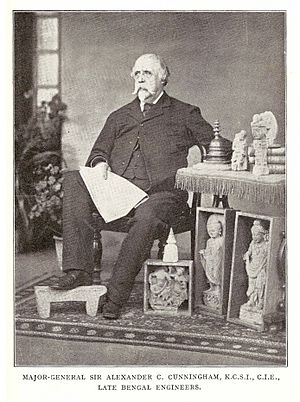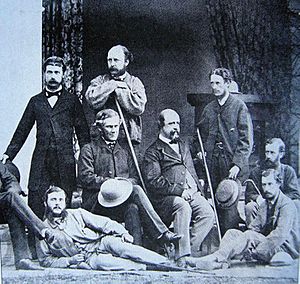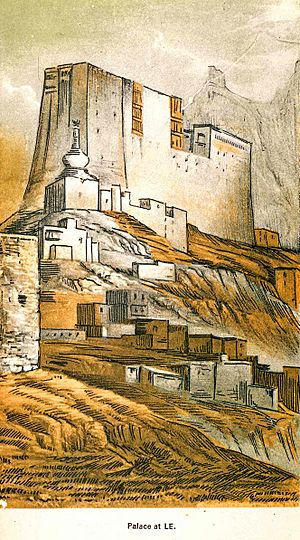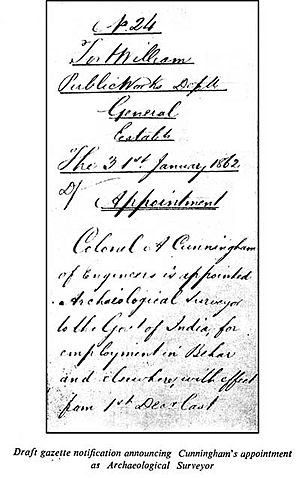Alexander Cunningham facts for kids
Quick facts for kids
Alexander Cunningham
|
|
|---|---|
 |
|
| Born | 23 January 1814 |
| Died | 28 November 1893 (aged 79) |
| Nationality | British |
| Occupation |
|
| Spouse(s) | Alice Cunningham (married 1840) |
| Children |
|
| Parent(s) |
|
| Relatives |
|
Major General Sir Alexander Cunningham KCIE CSI (born January 23, 1814 – died November 28, 1893) was a British army engineer. He worked with the Bengal Engineer Group in India. Later, he became very interested in India's history and ancient sites.
In 1861, he was chosen for a new job: archaeological surveyor for the government of India. He started and organized what is now known as the Archaeological Survey of India. This group helps find and protect old buildings and artifacts.
Cunningham wrote many books and collected lots of ancient items. Some of his collections were lost. But many gold and silver coins, along with beautiful Buddhist sculptures and jewelry, were bought by the British Museum in 1894. He was also the father of the famous mathematician Allan Cunningham.
Contents
Early Life and Career
Alexander Cunningham was born in London in 1814. His father, Allan Cunningham, was a Scottish poet. Alexander and his older brother, Joseph, went to school at Christ's Hospital in London.
Thanks to Sir Walter Scott, both brothers got to study at the East India Company's Addiscombe Military Seminary. This was a special school for future army officers. After that, they got more training at Chatham.
Alexander joined the Bengal Engineers when he was 19. He worked for the British Government of India for the next 28 years. He arrived in India in 1833 and soon met James Prinsep. Prinsep was a close friend and teacher to Cunningham. He shared his passion for Indian archaeology and ancient history with Alexander.
From 1836 to 1840, Cunningham worked for Lord Auckland, who was the Governor-General of India. During this time, he visited Kashmir, a place that was not well known then.
Military Service
In 1841, Cunningham became an engineer for the king of Oudh. In 1842, he helped the army stop an uprising in Bundelkhand. He then worked in Nowgong, central India. He also fought in the Battle of Punniar in 1843.
He became an engineer in Gwalior and built an arched stone bridge over the Morar River. In 1845–46, he helped build two boat bridges over the Beas river before the Battle of Sobraon.
In 1846, he helped mark boundaries with P. A. Vans Agnew. A second group, led by Cunningham, was set up in 1847. This group included Henry Strachey and Thomas Thomson. Their job was to mark the border between Ladakh and Tibet. This was after the First Anglo-Sikh War ended.
Cunningham's early book, Essay on the Aryan Order of Architecture (1848), came from his visits to temples in Kashmir. It also came from his travels in Ladakh. He was also part of the battles of Chillianwala and Gujrat in 1848–49. In 1851, he explored Buddhist monuments in Central India.
In 1856, he became chief engineer of Burma for two years. From 1858, he worked in the same job in the North-Western Provinces. He set up public works departments in both places. He was not in India during the Rebellion of 1857. He became a Colonel in the Royal Engineers in 1860. He retired in 1861 as a Major General.
Discovering Ancient India
Cunningham became very interested in ancient things early in his career. People had already started digging up old sites. For example, General Jean-Baptiste Ventura found many old coins by digging near pillars.
In 1834, Cunningham wrote about relics found in the Mankiala stupa. He dug at Sarnath in 1837 and made careful drawings of sculptures. In 1842, he dug at Sankassa and at Sanchi in 1851. In 1854, he published The Bhilsa Topes. This book tried to explain the history of Buddhism using old buildings.
By 1851, he started talking to the East India Company about the importance of an archaeological survey. He explained why it was important to fund this work. He said it would help the Indian government understand India's past. It would show that India was often divided into small states. But when India was united, it could fight off invaders.
After he retired from the Royal Engineers in 1861, Lord Canning appointed Cunningham as the archaeological surveyor. He held this job from 1861 to 1865. But then the job ended because there was not enough money.
Many people in the 1800s tried to find ancient Indian cities. They used clues from old Greek and Roman writings. They also used travel stories from people like Xuanzang and Faxian who visited India. Cunningham was able to find some of the places Xuanzang wrote about.
Some of his biggest achievements include finding:
- Aornos
- Taxila
- Sangala
- Srughna
- Ahichchhatra
- Bairat
- Sankisa
- Shravasti
- Kaushambi
- Padmavati
- Vaishali
- Nalanda
Unlike others, Cunningham always checked his findings by exploring the actual sites. Finding Taxila was hard because of mistakes in old writings. But Cunningham noticed that the Chinese travelers' descriptions were different. They said the journey to Taxila took three days, not two. Cunningham explored a site at Shah-dheri in 1863–64. He became sure that this was the correct place for Taxila. He found many old ruins there, including stupas and monasteries.
After his department closed in 1865, Cunningham went back to England. He wrote the first part of his book, Ancient Geography of India (1871). This part covered the Buddhist period. He never finished the second part, which was about the Muslim period. While in London, he also worked as a director for a bank.
In 1870, Lord Mayo started the Archaeological Survey of India again. Cunningham became its director-general in 1871. He returned to India and explored sites every winter. He dug and surveyed places from Taxila to Gaur. He wrote 24 reports. He also wrote other important books:
- The first volume of Corpus Inscriptionum Indicarum (1877), which had copies of the edicts of Ashoka.
- The Stupa of Bharhut (1879).
- The Book of Indian Eras (1883), which helped date old Indian items.
He retired from the Archaeological Survey in 1885 and went back to London. He continued his research and writing there.
Coin Collecting Interests
Cunningham collected many old coins. But many of them were lost in November 1884. The ship he was on, the Indus, sank off the coast of Ceylon. However, the British Museum managed to get most of his gold and silver coins.
He suggested to the Museum that they should use an arch from the Sanchi Stupa to mark the entrance of a new section on Indian history. He also wrote many articles for the Journal of the Asiatic Society and the Numismatic Chronicle.
Family and Personal Life
Two of Cunningham's brothers, Francis and Joseph, were also well known for their work in British India. Another brother, Peter, was famous for his book Handbook of London (1849).
Alexander Cunningham married Alicia Maria Whish in 1840. They had two sons:
- Lieutenant-Colonel Allan J. C. Cunningham (1842–1928), who was also an engineer.
- Sir Alexander F. D. Cunningham (1852–1935), who worked in the Indian Civil Service.
Cunningham died on November 28, 1893, at his home in South Kensington, London. He was buried at Kensal Green Cemetery. His wife had died before him. His two sons survived him.
Awards and Honors
Cunningham received several important awards:
- He was given the CSI on May 20, 1870.
- He received the CIE in 1878.
- In 1887, he was made a Knight Commander of the Order of the Indian Empire.
See also
 In Spanish: Alexander Cunningham para niños
In Spanish: Alexander Cunningham para niños




